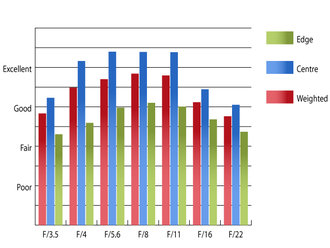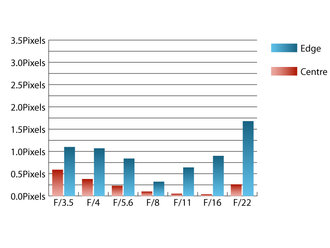Samyang 8mm T3.8 Asph IF MC Fisheye CS VDSLR Review
Samyang 8mm T3.8 Asph IF MC Fisheye CS VDSLR Performance
Although the lens is marked in T-stops, for the purposes of testing F-stops have been used here. At maximum aperture, sharpness is good in the centre, but only fair towards the edges of the frame. This characteristic is typical for fisheye lenses and stopping down improves sharpness across the frame. Peak quality is achieved between f/5.6 and f/11, where sharpness in the centre approaches outstanding levels and clarity towards the edges of the frame is good. | How to read our chartsThe blue column represents readings from the centre of the picture frame at the various apertures and the green is from the edges. Averaging them out gives the red weighted column.The scale on the left side is an indication of actual image resolution. The taller the column, the better the lens performance. Simple. For this review, the lens was tested on a Nikon D300 using Imatest. |
Levels of chromatic aberrations are acceptable, just exceeding one pixel width between f/3.5 and f/4 and dropping as the lens is stopped down to f/8. Diffraction causes fringing to become more prevalent at smaller apertures, exceeding 1.5 pixel widths at f/22.
 | How to read our chartsChromatic aberration is the lens' inability to focus on the sensor or film all colours of visible light at the same point. Severe chromatic aberration gives a noticeable fringing or a halo effect around sharp edges within the picture. It can be cured in software.Apochromatic lenses have special lens elements (aspheric, extra-low dispersion etc) to minimize the problem, hence they usually cost more. For this review, the lens was tested on a Nikon D300 using Imatest. |
Straight lines placed towards the edges of the frame curve wildly, as is typical of fisheye lenses due to the extreme field of view. However, this lens produces images with stereographic projection, which means that images are more natural looking than typically found with fisheye lenses that produce images with equal-area projection. Objects placed near the edges of the frame appear less squashed than those taken with a lens that produces equal-area or orthographic projection.
Formal testing of illumination falloff towards the corners isn't possible, due to the extreme angle of view. In use, at f/3.5 and f/4 a noticeable, but gradual falloff in brightness can be seen appearing towards the corners, but this appears visually even by f/8.
Flare and loss of contrast when shooting with bright light sources in the frame are both controlled pretty well. A little flare and loss of contrast may be seen with a bright source of light in the frame when shooting at wide apertures, but this is reduced as the lens is stopped down.
Add your message
Login required
Please login here or if you've not registered, you can register here. Registering is safe, quick and free.
Please login here or if you've not registered, you can register here. Registering is safe, quick and free.
photodo Stats
1102 lenses
428 MTF tests
74 in-depth photodo reviews
100+ users join each day
Help the lens community by reviewing or rating a lens today via our lens search
428 MTF tests
74 in-depth photodo reviews
100+ users join each day
Help the lens community by reviewing or rating a lens today via our lens search
Latest Lens Reviews
- Chinon 28mm f/2.8 Vintage Lens Review
- Canon EF 70-200mm f/4L IS II USM Lens Review
- Samyang AF 85mm f/1.4 EF Review
- Sigma 70mm f/2.8 DG Macro Art Review
- Samyang AF 24mm f/2.8 FE Review
- Meike 50mm f/1.7 Review
- Tamron 70-210mm f/4 Di VC USD Review
- Lensbaby Burnside 35mm f/2.8 Review
- Asahi Super Takumar 50mm f/1.4 Review
- Asahi Super-Multi-Coated Takumar 135mm f/3.5 Review
